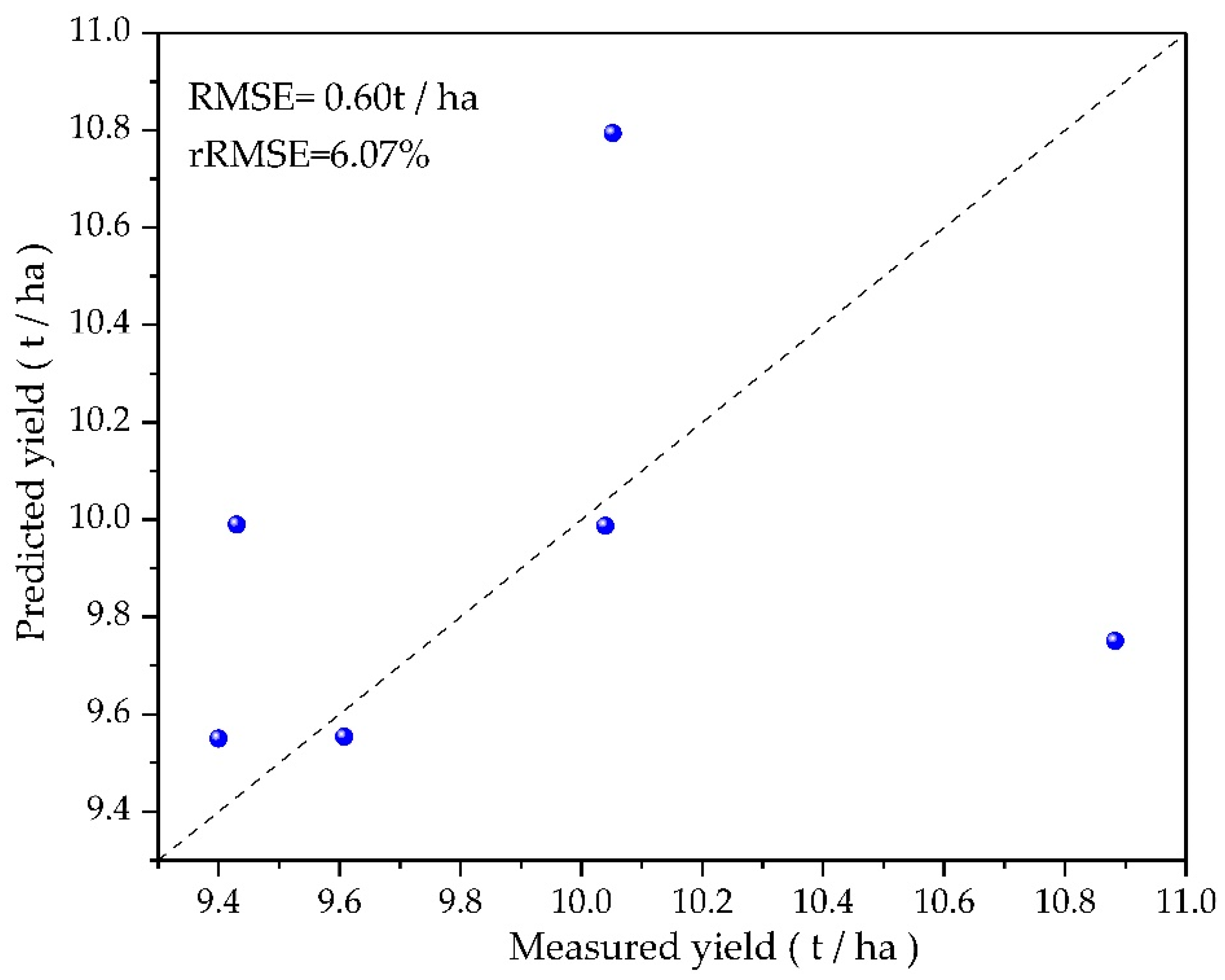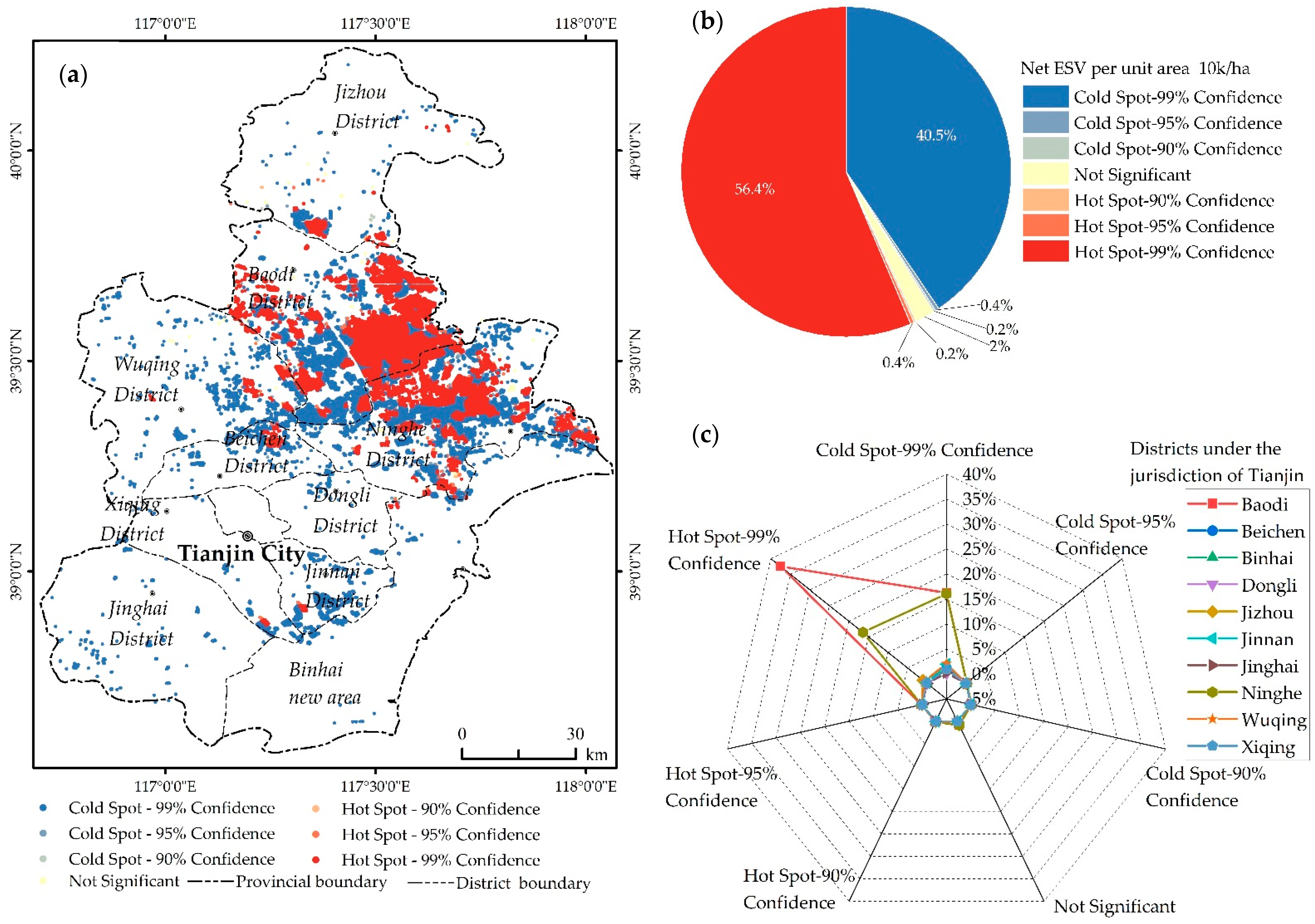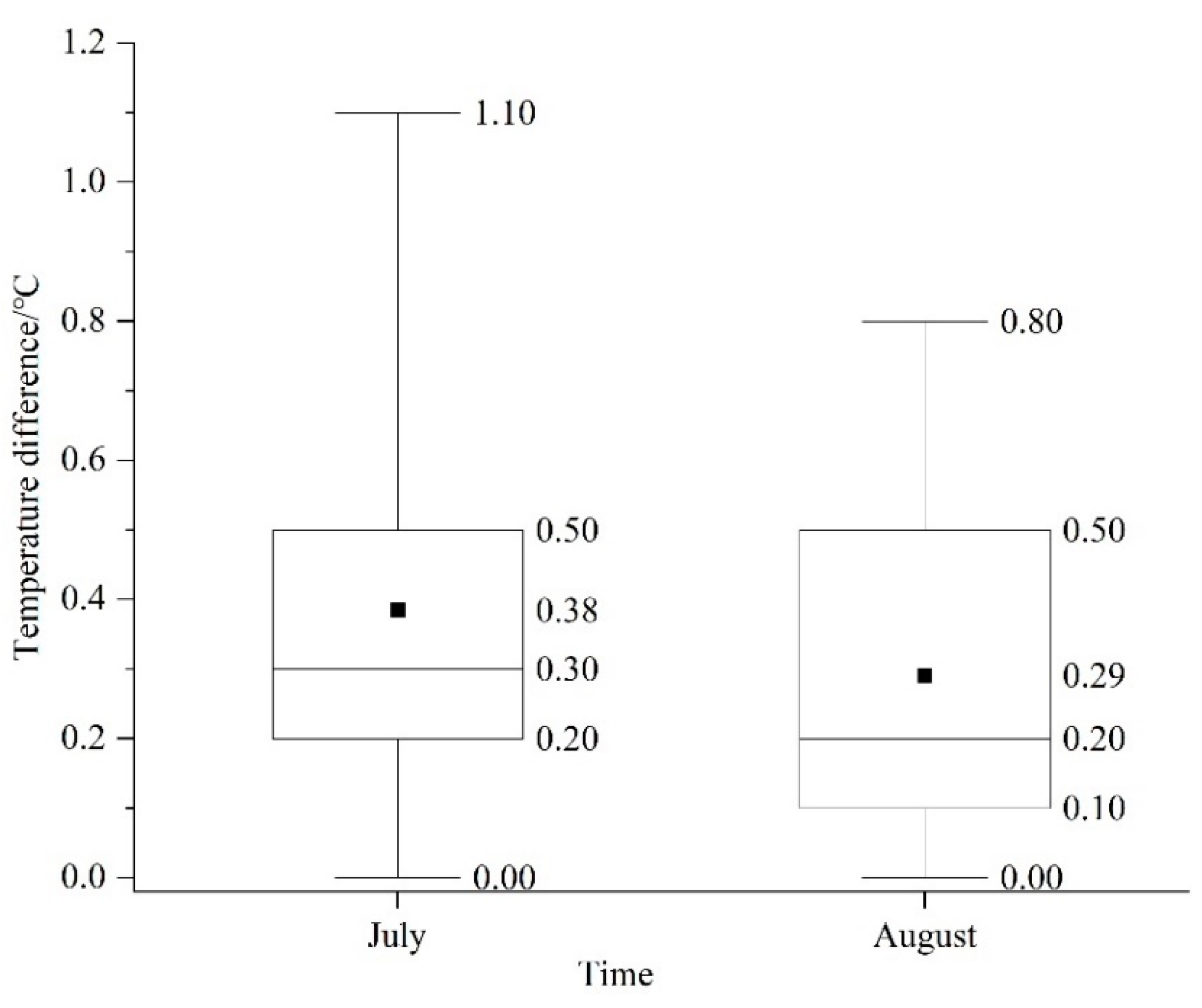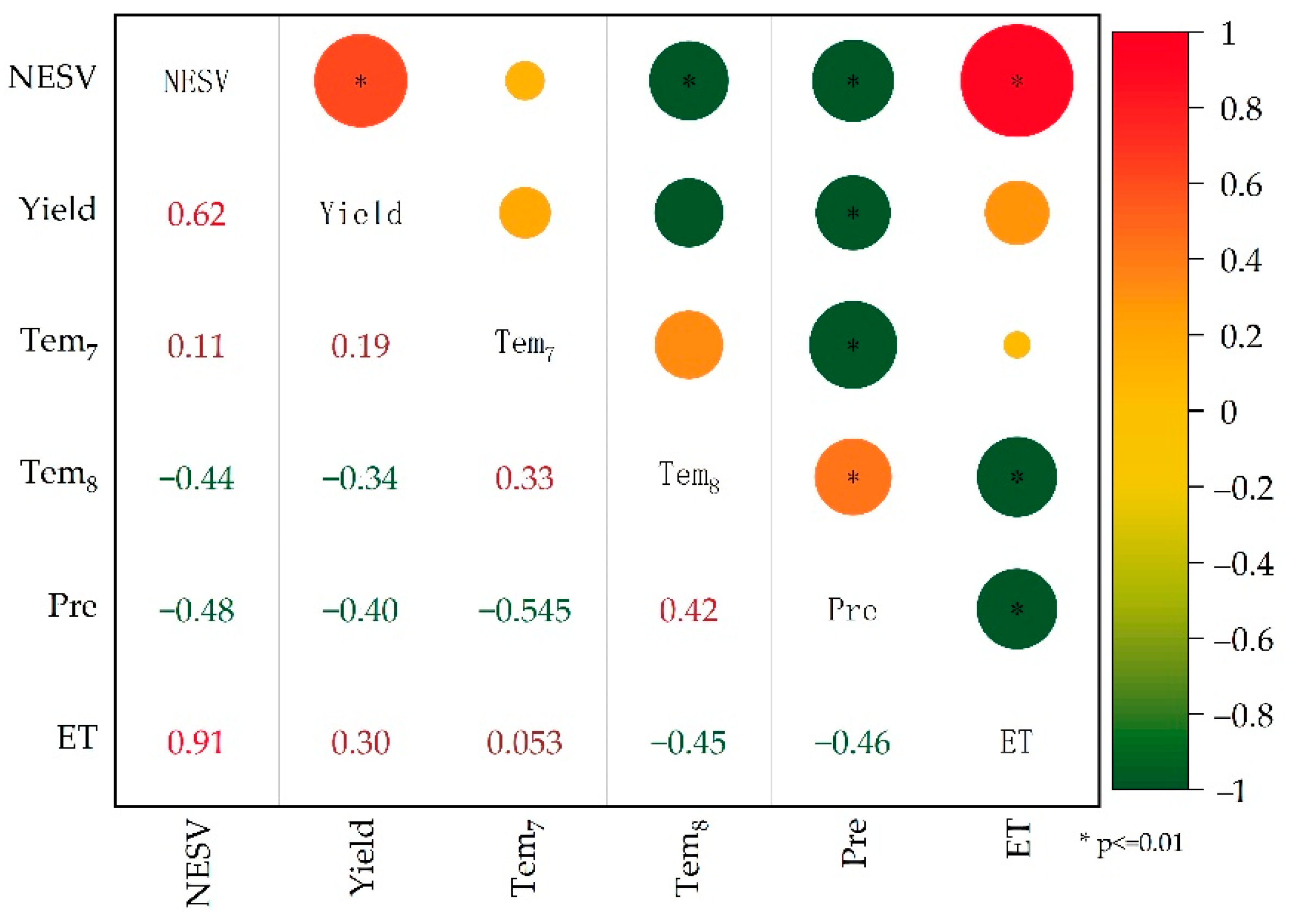Ecosystem Service Value Estimation of Paddy Field Ecosystems Based on Multi-Source Remote Sensing Data
Abstract
:1. Introduction
2. Materials and Methods
2.1. Description of Study Area
2.2. Data Acquisition and Processing
2.2.1. Sentinel-2 Data
2.2.2. Gross Primary Productivity (GPP)
2.2.3. Evapotranspiration (ET)
2.2.4. Precipitation and Temperature Data
2.2.5. Rice Yield Data
2.3. Methods
2.3.1. Remote Sensing Interpretation of Paddy Fields
2.3.2. ESV Accounting Methods
- (1)
- Provisioning service value
- I.
- The value of primary products was estimated as:
- (2)
- Regulation services value
- I.
- Carbon fixation and oxygen release
- II.
- Climate regulation
- III.
- Groundwater recharge
- IV.
- Flood regulation
- V.
- Material purification
- (3)
- Cultural service value
- I.
- Landscape aesthetic value
- (4)
- Negative reconciliation value
- I.
- Greenhouse gas emission
- II.
- Water consumption
- III.
- Agrochemical pollution
- (5)
- NESV
2.3.3. Hot Spot Analysis
3. Results
3.1. ESV of PFE
3.1.1. Provisioning Service Value
3.1.2. Regulating Service Value
3.1.3. Cultural Service Value
3.1.4. Negative Reconciliation Value
3.1.5. Net Ecosystem Service Value
3.2. Quantity of Products in PFE
3.2.1. Quantity of Primary Products
3.2.2. Quantity of Regulating Service Materials
3.2.3. Quantity of Material of Negative Regulating Service
3.3. Spatial Distribution of Ecosystem Service Value
4. Discussion
4.1. Comparison of Existing Studies
4.2. Cooling Function of Paddy Fields
4.3. Influencing Factors of ESV
4.4. Recommendations and Prospect
5. Conclusions
Supplementary Materials
Author Contributions
Funding
Institutional Review Board Statement
Informed Consent Statement
Data Availability Statement
Acknowledgments
Conflicts of Interest
References
- Daily, G.C. Nature’s Services: Societal Dependence on Natural Ecosystems; Yale University Press: New Haven, CT, USA, 1997. [Google Scholar] [CrossRef]
- Daily, G.C.; Derqvist, T.; Aniyar, S.; Arrow, K.; Dasgupta, P.; Ehrlich, P.R.; Folke, C.; Jansson, A.; Jansson, B.; Kautsky, N.; et al. The value of nature and the nature of value. Science 2000, 289, 395–396. [Google Scholar] [CrossRef] [PubMed] [Green Version]
- Costanza, R.; D’Arge, R.; de Groot, R.; Farber, S.; Grasso, M.; Hannon, B.; Limburg, K.; Naeem, S.; O’Neill, R.V.; Paruelo, J.; et al. The value of the world’s ecosystem services and natural capital. Nature 1997, 387, 253–260. [Google Scholar] [CrossRef]
- Millennium Ecosystem Assessment: Ecosystems and Human Well-Being; World Resources Institute: Washington, DC, USA, 2005.
- Pearce, D.W.; Turner, R.K.; Turner, R.K. Economics of Natural Resources and the Environment; Johns Hopkins University Press: Baltimore, MD, USA, 1990. [Google Scholar]
- Kramer, R.A.; Sharma, N.P.; Munasinghe, M. Valuing Tropical Forests: Methodology and Case Study of Madagascar; World Bank: Bretton Woods, NH, USA, 1995. [Google Scholar]
- Kreuter, U.P.; Harris, H.G.; Matlock, M.D.; Lacey, R.E. Change in ecosystem service values in the San Antonio area, Texas. Ecol. Econ. 2001, 39, 333–346. [Google Scholar] [CrossRef]
- Xie, G.; Lu, C.; Leng, Y.; Zheng, D.; LI, S. Ecological assets valuation of the Tibetan Plateau. J. Nat. Resour. 2003, 18, 189–196. [Google Scholar] [CrossRef]
- Xie, G.; Zhen, L.; Lu, C.; Xiao, Y.; Chen, D. Expert knowledge based valuation method of ecosystem services in China. J. Nat. Resour. 2008, 23, 911–919. [Google Scholar] [CrossRef]
- Costanza, R.; de Groot, R.; Sutton, P.; van der Ploeg, S.; Anderson, S.J.; Kubiszewski, I.; Farber, S.; Turner, R.K. Changes in the global value of ecosystem services. Glob. Environ. Change 2014, 26, 152–158. [Google Scholar] [CrossRef]
- Song, X. Global Estimates of Ecosystem Service Value and Change: Taking Into Account Uncertainties in Satellite-based Land Cover Data. Ecol. Econ. 2018, 143, 227–235. [Google Scholar] [CrossRef]
- Sannigrahi, S.; Bhatt, S.; Rahmat, S.; Paul, S.K.; Sen, S. Estimating global ecosystem service values and its response to land surface dynamics during 1995–2015. J. Environ. Manag. 2018, 223, 115–131. [Google Scholar] [CrossRef]
- Li, G.; Fang, C.; Wang, S. Exploring spatiotemporal changes in ecosystem-service values and hotspots in China. Sci. Total Environ. 2016, 545, 609–620. [Google Scholar] [CrossRef]
- Song, W.; Deng, X. Land-use/land-cover change and ecosystem service provision in China. Sci. Total Environ. 2017, 576, 705–719. [Google Scholar] [CrossRef] [PubMed]
- Xie, G.; Zhang, C.; Zhen, L.; Zhang, L. Dynamic changes in the value of China’s ecosystem services. Ecosyst. Serv. 2017, 26, 146–154. [Google Scholar] [CrossRef]
- Xing, L.; Xue, M.; Wang, X. Spatial correction of ecosystem service value and the evaluation of eco-efficiency: A case for China’s provincial level. Ecol. Indic. 2018, 95, 841–850. [Google Scholar] [CrossRef]
- Yu, Y.; Yu, M.; Lin, L.; Chen, J.; Li, D.; Zhang, W.; Cao, K. National Green GDP Assessment and Prediction for China Based on a CA-Markov Land Use Simulation Model. Sustainability 2019, 11, 576. [Google Scholar] [CrossRef] [Green Version]
- Liu, Y.; Sun, H.; Shi, L.; Wang, H.; Xiu, Z.; Qiu, X.; Chang, H.; Xie, Y.; Wang, Y.; Wang, C. Spatial-Temporal Changes and Driving Factors of Land-Use Eco-Efficiency Incorporating Ecosystem Services in China. Sustainability 2021, 13, 728. [Google Scholar] [CrossRef]
- Xue, M.; Luo, Y. Dynamic variations in ecosystem service value and sustainability of urban system: A case study for Tianjin city, China. Cities 2015, 46, 85–93. [Google Scholar] [CrossRef]
- Hu, M.; Li, Z.; Wang, Y.; Jiao, M.; Li, M.; Xia, B. Spatio-temporal changes in ecosystem service value in response to land-use/cover changes in the Pearl River Delta. Resour. Conserv. Recycl. 2019, 149, 106–114. [Google Scholar] [CrossRef]
- Wang, Y.; Zhang, S.; Zhen, H.; Chang, X.; Shataer, R.; Li, Z. Spatiotemporal Evolution Characteristics in Ecosystem Service Values Based on Land Use/Cover Change in the Tarim River Basin, China. Sustainability 2020, 12, 7759. [Google Scholar] [CrossRef]
- Zhou, Y.; Zhang, X.; Yu, H.; Liu, Q.; Xu, L. Land Use-Driven Changes in Ecosystem Service Values and Simulation of Future Scenarios: A Case Study of the Qinghai–Tibet Plateau. Sustainability 2021, 13, 4079. [Google Scholar] [CrossRef]
- Xi, H.; Cui, W.; Cai, L.; Chen, M.; Xu, C. Evaluation and Prediction of Ecosystem Service Value in the Zhoushan Islands Based on LUCC. Sustainability 2021, 13, 2302. [Google Scholar] [CrossRef]
- Wang, B.; Yang, T. Assessing Impact of Land Use Change on the Ecosystem Service Value in Yinchuan City from 1980 to 2018. Sustainability 2021, 13, 8311. [Google Scholar] [CrossRef]
- Xu, Y.; Xiao, F. Assessing Changes in the Value of Forest Ecosystem Services in Response to Climate Change in China. Sustainability 2022, 14, 4773. [Google Scholar] [CrossRef]
- Meng, L.; Dong, J. LUCC and Ecosystem Service Value Assessment for Wetlands: A Case Study in Nansi Lake, China. Water 2019, 11, 1597. [Google Scholar] [CrossRef] [Green Version]
- Ouyang, Z.; Wang, X.; Miao, H. A primary study on Chinese terrestrial ecosystem services and their ecological-economic values. Acta Ecol. Sin. 1999, 19, 607–613. [Google Scholar] [CrossRef]
- Ouyang, Z.; Zhu, C.; Yang, G.; Xu, W.; Zheng, H.; Zhang, Y.; Xiao, Y. Gross ecosystem product: Concept, accounting framework and case study. Acta Ecol. Sin. 2013, 33, 6747–6761. [Google Scholar] [CrossRef]
- Ouyang, Z.; Song, C.; Zheng, H.; Polasky, S.; Xiao, Y.; Bateman, I.J.; Liu, J.; Ruckelshaus, M.; Shi, F.; Xiao, Y.; et al. Using gross ecosystem product (GEP) to value nature in decision making. Proc. Natl. Acad. Sci. USA 2020, 117, 14593–14601. [Google Scholar] [CrossRef]
- Area of Main Crops. Available online: https://data.stats.gov.cn/easyquery.htm?cn=C01 (accessed on 20 May 2022).
- Lin, W.; Xu, D.; Guo, P.; Wang, D.; Li, L.; Gao, J. Exploring variations of ecosystem service value in Hangzhou Bay Wetland, Eastern China. Ecosyst. Serv. 2019, 37, 100944. [Google Scholar] [CrossRef]
- Rasheed, S.; Venkatesh, P.; Singh, D.R.; Renjini, V.R.; Jha, G.K.; Sharma, D.K. Ecosystem valuation and eco-compensation for conservation of traditional paddy ecosystems and varieties in Kerala, India. Ecosyst. Serv. 2021, 49, 101272. [Google Scholar] [CrossRef]
- Masumoto, T. Multifunctional roles of paddy irrigation in monsoon Asia. In Proceedings of the 3rd World Water Forum(WWF), Agriculture, Food and Water, Kyoto, Japan, 22–23 March 2003; pp. 324–327. [Google Scholar]
- Xiao, Y.; Xie, G.; Lu, C.; Ding, X.; Lv, Y. The gas regulation function of rice paddy ecosystems and its value. J. Nat. Resour. 2004, 19, 617–623. [Google Scholar] [CrossRef]
- Chen, D.; Chen, J.; Luo, C. Discussion on paddy field ecosystem service and its economic value evaluation Method. Environ. Sci. Technol. 2005, 61–63, 112–113. [Google Scholar] [CrossRef]
- Li, X.; Chen, S.; Chen, Y.; Gao, W.; Ma, Y.; Ma, L. Evaluation of the multi-cropping ecosystem services under conservation tillage paddy field in Sichuan basin. Acta Ecol. Sin. 2006, 26, 3782–3788. [Google Scholar] [CrossRef]
- Zhou, X.; Li, F.; Xu, C.; Fang, F. Evaluation of ecosystem service value of paddy field constructed wetland in Zhejiang. J. Zhejiang Agric. Sci. 2009, 971–974. [Google Scholar] [CrossRef]
- Xiao, Y.; Xie, G. Comprehensive Valuation of the Ecosystem Services of Rice Paddies in Shanghai. Resour. Sci. 2009, 31, 38–47. [Google Scholar] [CrossRef]
- Yan, X. Methane emission from rice fields in mainland China: Amount and seasonal and spatial distribution. J. Geophys. Res. 2003, 108. [Google Scholar] [CrossRef]
- Natuhara, Y. Ecosystem services by paddy fields as substitutes of natural wetlands in Japan. Ecol. Eng. 2013, 56, 97–106. [Google Scholar] [CrossRef]
- Yoon, C.G. Wise use of paddy rice fields to partially compensate for the loss of natural wetlands. Paddy Water Environ. 2009, 7, 357–366. [Google Scholar] [CrossRef]
- Li, F.; Xu, C.; Zhou, X.; Fang, F. Study on ecological compensation mechanism of terraced rice based on ecosystem service value. China Rice 2011, 17, 11–15. [Google Scholar] [CrossRef]
- Zheng, C.; Guo, X.; Zu, Y.; He, Y.; Xu, Y. Evaluation on service value of paddy field ecosystem in Yuanyang terraces. Ecol. Sci. 2018, 37, 124–130. [Google Scholar] [CrossRef]
- Xue, B.; Zhang, L.; Zhang, T.; Sun, W.; Li, Z. Evaluation of paddy field eco-system’s service value: Taking example Hunan province for example. China Rural. Water Hydropower 2020, 52–57. [Google Scholar]
- Yang, T.; Sun, Y. Evaluation of the net value of paddy ecosystem services in China. J. China Agric. Univ. 2020, 25, 159–172. [Google Scholar] [CrossRef]
- Fu, Z.; Liu, Q.; Yang, T. Evaluation of the net value of paddy ecosystem services in Hunan province. J. Hunan Univ. Arts Sci. Sci. Technol. 2021, 33, 58–62. [Google Scholar] [CrossRef]
- Liu, Y.; Zhou, Q.; Yu, Q.; Wu, W. Analysis of spatial pattern and ecological service value changes of large-scale regional paddy fields based on remote sensing data. Smart Agric. 2020, 2, 43–57. [Google Scholar] [CrossRef]
- Announcement No. 290 of the Ministry of Agriculture and Rural Affairs of the People’s Republic of China. Available online: http://www.moa.gov.cn/govpublic/ncpzlaq/202005/t20200509_6343524.htm (accessed on 10 May 2022).
- Abatzoglou, J.T.; Dobrowski, S.Z.; Parks, S.A.; Hegewisch, K.C. TerraClimate, a high-resolution global dataset of monthly climate and climatic water balance from 1958–2015. Sci. Data 2018, 5, 170191. [Google Scholar] [CrossRef] [PubMed] [Green Version]
- Ouyang, Z.; Xiao, Y.; Zhu, C.; Zheng, H. Theory and Method of Gross Ecosystem Product (GEP) Accounting; Science Press: Beijing, China, 2021. [Google Scholar]
- Hu, X.; Wu, J.; Zhang, X. Study of the Methodology of Evaluating Paddy Ecosystem’s Multifunction. Environ. Prot. Sci. 2017, 43, 75–81. [Google Scholar] [CrossRef]
- Peng, D. The Study on the Method of Rice Yield Estimation Using Statistical and MODIS Data. Ph.D. Thesis, Zhejiang University, Hangzhou, China, 2009. [Google Scholar]
- Li, Q. Main crop straw resources and utilization ways in Tianjin. Sci. Technol. Tianjin Agric. For. 2018, 44–46. [Google Scholar] [CrossRef]
- Pachauri, R.K.; Allen, M.R.; Barros, V.R.; Broome, J.; Cramer, W.; Christ, R.; Church, J.A.; Clarke, L.; Dahe, Q.; Dasgupta, P.; et al. Climate Change 2014: Synthesis Report. Contribution of Working Groups I, II and III to the Fifth Assessment Report of the Intergovernmental Panel on Climate Change; IPCC: Geneva, Switzerland, 2014. [Google Scholar]
- Wen, Y.; Sun, Q.; Yan, Y.; Xiao, M.; Song, W.; Yang, J. Impacts of the terrestrial ecosystem changes on the carbon fixation and oxygen release services in the Guangdong-Hong Kong-Macao Greater Bay Area. Acta Ecol. Sin. 2020, 40, 8482–8493. [Google Scholar] [CrossRef]
- Liu, L.; Yin, C.; Qian, X. Calculation methods of paddy ecosystem service value and application: A case study of Suzhou City. Prog. Geogr. 2015, 34, 92–99. [Google Scholar] [CrossRef]
- Implementation Opinions on Promoting the Comprehensive Reform of Agricultural Water Price in Our City. Available online: http://www.tj.gov.cn/zwgk/szfgb/wjhySite/202005/t20200520_2462856.html (accessed on 10 May 2022).
- Yoshikawa, N.; Nagao, N.; Misawa, S. Evaluation of the flood mitigation effect of a Paddy Field Dam project. Agr. Water Manag. 2010, 97, 259–270. [Google Scholar] [CrossRef]
- Notice on the Adjustment of Emission Fee Collection Standards for Four Pollutants such as SO2 in Tianjin. Available online: http://sthj.tj.gov.cn/ZWGK4828/ZCWJ6738/sjwj/202010/t20201020_3963185.html (accessed on 10 May 2022).
- Ma, X.; Ren, Z.; Sun, G. The calculation and assessment to the values of air purification by vegetation in Xi’ an City. Chin. J. Eco-Agric. 2004, 12, 185–187. [Google Scholar]
- Lin, Y. Analysis on Environment and Educational Economic Benefit of Rice Field Ecological Management in Guandu Natural Park. Master’s Thesis, Taiwan University, Taipei, Taiwan, 2002. [Google Scholar]
- Nie, J. Study on Multifunctional Value of Rice Field Ecosystem in Hunan Province. Master’s Thesis, Hunan Agricultural University, Changsha, China, 2012. [Google Scholar]
- Xie, G.; Xiao, Y.; Zhen, L.; Chun, X. Study on ecosystem services value of food production in China. Chin. J. Eco-Agric. 2005, 13, 10–13. [Google Scholar]
- Pal, S.; Debanshi, S. Methane emissions only negligibly reduce the ecosystem service value of wetlands and rice paddies in the mature Ganges Delta. Environ. Sci. Pollut. R 2022, 29, 27894–27908. [Google Scholar] [CrossRef] [PubMed]
- Zhang, X. Characteristics of CH4 and N2O Emissions and the Reduction Strategy in Paddy Fields, Shanghai Region. Ph.D. Thesis, Shanghai Jiao Tong University, Shanghai, China, 2016. [Google Scholar]
- Xiang, P.; Huang, H.; Yan, H.; Zhou, Y.; Zheng, H. Environmental cost of rice production in Dongting Lake area of Hunan Province. Chin. J. Appl. Ecol. 2005, 16, 183–189. [Google Scholar]
- Ord, J.K.; Getis, A. Local spatial autocorrelation statistics: Distributional issues and an application. Geogr. Anal. 1995, 27, 286–306. [Google Scholar] [CrossRef]
- Mitchel, A. The ESRI Guide to GIS Analysis, Volume 2: Spartial Measurements and Statistics; ESRI Press: Redlands, CA, USA, 2005. [Google Scholar]
- National Development and The Reform Committee. National Compendium of Agricultural Product Cost-Benefit Data 2021; China Statistical Press: Beijing, China, 2021.
- Niu, L. Ecological Funcation Evaluation of Qingyuan Paddy Field. Master’s Thesis, Shenyang Agriculture University, Shenyang, China, 2018. [Google Scholar]
- Wang, K.; Huang, G.; Luo, Q.; Li, Z. Evaluation of ecological service value of rice field multi-cropping planting system in the hilly area of Jiangnan. Acta Agric. Jiangxi 2010, 22, 157–160. [Google Scholar] [CrossRef]
- Zhou, Z. Study on the Benefits of Ecological and Economic of Different Farmland Ecological System in Jinjing Town Changsha County. Master’s Thesis, Hunan Agricultural University, Changsha, China, 2014. [Google Scholar]
- Yang, Y. Paddy field ecosystem services valuation in the Jiang yan city. Master’s Thesis, Yangzhou University, Yangzhou, China, 2011. [Google Scholar]
- Kim, T.; Gim, U.; Kim, J.S.; Kim, D. The multi-functionality of paddy farming in Korea. Paddy Water Environ. 2006, 4, 169–179. [Google Scholar] [CrossRef]
- He, S.; Tian, J.; Zhang, Y. Millennium Ecosystem Assessment. Verification and comparison of three high-resolution surface evapotranspiration products in North China. Resour. Sci. 2020, 42, 2035–2046. [Google Scholar] [CrossRef]
- Tang, J.; Wang, J.; Li, Z.; Wang, S.; Qu, Y. Effects of Irrigation Regime and Nitrogen Fertilizer Management on CH4, N2O and CO2 Emissions from Saline–Alkaline Paddy Fields in Northeast China. Sustainability 2018, 10, 475. [Google Scholar] [CrossRef] [Green Version]
- Yang, S.; Xiao, Y.; Sun, X.; Ding, J.; Jiang, Z.; Xu, J. Biochar improved rice yield and mitigated CH4 and N2O emissions from paddy field under controlled irrigation in the Taihu Lake Region of China. Atmos. Environ. 2019, 200, 69–77. [Google Scholar] [CrossRef]






| Type of Spot | Z-Score | Confidence (%) |
|---|---|---|
| Hot spot | >2.58 | 99 |
| Hot spot | 2.58 ≥ z > 1.96 | 95 |
| Hot spot | 1.96 ≥ z > 1.65 | 90 |
| Not Significant spot | 1.65 ≥ z ≥ −1.65 | / |
| Cold spot | −1.96 ≤ z < −1.65 | 90 |
| Cold spot | −2.58 ≤ z < −1.96 | 95 |
| Cold spot | z < −2.58 | 99 |
| Ecological Service Types | Items | ESV RMB 10 k | Value of Unit Area RMB/ha | Percentage % | |
|---|---|---|---|---|---|
| Provisioning services | Primary products supply | 2.87 | 5293.25 | 8.08 | |
| Regulating service | Carbon fixation and oxygen release | 5.43 | 10,014.81 | 15.29 | |
| Climate regulation | 21.77 | 40,124.58 | 61.27 | ||
| Groundwater recharge | 0.84 | 1545.78 | 2.36 | ||
| Flood regulation | 2.46 | 4530.00 | 6.92 | ||
| Material purification | air purification | 1.05 | 1944.00 | 2.97 | |
| water purification | 1.10 | 2027.25 | 3.10 | ||
| Cultural service | Landscape aesthetics | 0.0048 | 8.80 | 0.01 | |
| Positive ESV summary | 35.53 | 65,488.47 | / | ||
| Negative regulation service | Greenhouse gas emission | 4.95 | 9126.44 | 84.72 | |
| Water consumption | 0.33 | 611.59 | 5.68 | ||
| Agricultural chemical pollution | 0.56 | 1034.02 | 9.60 | ||
| Negative ESV summary | 5.84 | 10,772.04 | / | ||
| Net total ESV | 29.68 | 54,716.42 | / | ||
| Ecological Service Types | Items | Measurement Indicators | Unit | Quantity of Physical Product | |
|---|---|---|---|---|---|
| Provisioning services | Primary products supply | rice | 104 t | 51.00 | |
| straw | 104 t | 67.82 | |||
| Regulating service | Carbon fixation and oxygen release | carbon fixation | 104 t | 26.15 | |
| oxygen release | 104 t | 565.58 | |||
| Groundwater recharge | 108 m3 | 2.72 | |||
| Flood regulation | 108 m3 | 1.63 | |||
| Material purification | Purified air | SO2 | 104 t | 0.24 | |
| nitrogen oxide | 104 t | 0.18 | |||
| dust blocking | 104 t | 4.99 | |||
| Water purification | BOD | 104 t | 0.09 | ||
| COD | 104 t | 0.14 | |||
| Negative regulation service | Greenhouse gas emission | 104 t | 49.69 | ||
| Water consumption | 108 m3 | 6.17 | |||
| Ecological Service Types | Items | This Study | [36] A | [37] B | [38] C | [42] | [44] F | [56] G | [62] H | [70] I | [71] J | [72] K | [73] L | ||
|---|---|---|---|---|---|---|---|---|---|---|---|---|---|---|---|
| D | E | ||||||||||||||
| Provisioning services | Primary products supply | 5293 | 8933 | 33,685 | 9778 | 13,877 | 12,115 | 22,100 | 11,913 | 3643 | 15,500 | 18,622 | 16,697 | 17,590 | |
| Regulating service | Carbon fixation and oxygen release | 10,015 | 8734 | 19,152 | / | 11,141 | 9726 | 2300 | 3295 | 10,643 | 16,500 | 24,282 | 5071 | 3430 | |
| Climate regulation | 40,125 | / | 16,174 | 11,406 | 16,175 | 15,294 | 1700 | 32,942 | 813 | 1000 | / | / | 26,330 | ||
| Groundwater recharge | 1546 | 45,931 | / | 1891 | 11,518 | 12,009 | 15,000 | 19,200 | 9000 | 600 | / | / | / | ||
| Flood regulation | 4530 | / | / | / | / | / | / | 3473 | 1463 | 1400 | / | / | 3000 | ||
| Material purification | air purification | 1944 | / | 47,313 | 941 | / | / | / | 2610 | / | / | / | 204 | 500 | |
| water purification | 2027 | / | 12,530 | / | / | / | 800 | 2027 | 810 | / | / | ||||
| Cultural service | Landscape aesthetic | 9 | / | / | / | / | / | 10 | 9 | / | / | / | / | ||
| Subtotal | 65,488 | 63,598 | 128,854 | 24,016 | 52,711 | 49,144 | 41,910 | 75,470 | 26,381 | 35,000 | 42,904 | 21,972 | 50,850 | ||
| Negative regulation service | GHG emission | 9126 | / | / | / | 2385 | 2385 | 18,300 | 8244 | 7524 | 600 | / | / | 10,140 | |
| Water consumption | 612 | / | / | / | / | / | / | / | 4071 | 300 | / | / | / | ||
| Agricultural chemical pollution | 1034 | / | / | / | / | / | / | 1018 | 691 | 100 | / | 1961 | 1240 | ||
| Subtotal | 10,772 | / | / | / | 2385 | 2385 | 18,300 | 9262 | 12,286 | 1000 | 0 | 1961 | 11,380 | ||
| Net total ecosystem service value | 54,716 | 63,598 | 128,854 | 24,016 | 50,326 | 46,759 | 23,610 | 66,207 | 14,095 | 34,000 | 42,904 | 20,011 | 39,470 | ||
Publisher’s Note: MDPI stays neutral with regard to jurisdictional claims in published maps and institutional affiliations. |
© 2022 by the authors. Licensee MDPI, Basel, Switzerland. This article is an open access article distributed under the terms and conditions of the Creative Commons Attribution (CC BY) license (https://creativecommons.org/licenses/by/4.0/).
Share and Cite
Huang, T.; Huang, W.; Wang, K.; Li, Y.; Li, Z.; Yang, Y. Ecosystem Service Value Estimation of Paddy Field Ecosystems Based on Multi-Source Remote Sensing Data. Sustainability 2022, 14, 9466. https://doi.org/10.3390/su14159466
Huang T, Huang W, Wang K, Li Y, Li Z, Yang Y. Ecosystem Service Value Estimation of Paddy Field Ecosystems Based on Multi-Source Remote Sensing Data. Sustainability. 2022; 14(15):9466. https://doi.org/10.3390/su14159466
Chicago/Turabian StyleHuang, Tiecheng, Wenjiang Huang, Kun Wang, Yongkang Li, Zhenhai Li, and Yong’an Yang. 2022. "Ecosystem Service Value Estimation of Paddy Field Ecosystems Based on Multi-Source Remote Sensing Data" Sustainability 14, no. 15: 9466. https://doi.org/10.3390/su14159466
APA StyleHuang, T., Huang, W., Wang, K., Li, Y., Li, Z., & Yang, Y. (2022). Ecosystem Service Value Estimation of Paddy Field Ecosystems Based on Multi-Source Remote Sensing Data. Sustainability, 14(15), 9466. https://doi.org/10.3390/su14159466








